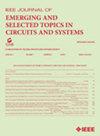Optimizing Thermal Performance in 2.5D Systems Using Embedded Isolators
IF 3.8
2区 工程技术
Q2 ENGINEERING, ELECTRICAL & ELECTRONIC
IEEE Journal on Emerging and Selected Topics in Circuits and Systems
Pub Date : 2025-08-05
DOI:10.1109/JETCAS.2025.3595909
引用次数: 0
Abstract
This paper investigates thermal management in tightly integrated heterogeneous chiplet systems, focusing on a novel approach using embedded thermal isolators. In many 2.5D systems, such as modern enterprise GPUs, thermally sensitive chiplets like High Bandwidth Memory (HBM) are thermally coupled to high-power compute chiplets, leading to performance degradation. We propose and evaluate the use of thermal isolators embedded within the heat spreader to effectively thermally decouple chiplets. Our thermal simulations of a water-cooled 2.5D integrated GPU system indicate that conventional approaches like thermally-aware floorplanning are less effective due to the dominant heat transfer through the heat spreader. In contrast, our proposed thermal isolators can significantly increase thermal isolation between chiplets (by up to 61%), or even reduce overall average peak chip temperature (by up to 22.5%). We develop a closed-loop workflow incorporating thermal results to quantify performance impacts of thermal-induced throttling, finding that in an example GPU+HBM system, the isolator approach can yield performance gains of up to 37% for memory-bound workloads. These findings open up new avenues for thermal management and thermal-system co-optimization in 2.5D heterogeneous integrated systems, potentially enabling more efficient and higher-performing chiplet-based architectures.使用嵌入式隔离器优化2.5D系统的热性能
本文研究了紧密集成的异质芯片系统的热管理,重点研究了一种使用嵌入式热隔离器的新方法。在许多2.5D系统中,例如现代企业gpu,像高带宽存储器(HBM)这样的热敏小芯片与高功率计算小芯片热耦合,导致性能下降。我们提出并评估了在散热器内嵌入热隔离器的使用,以有效地对芯片进行热解耦。我们对水冷2.5D集成GPU系统的热模拟表明,由于主要通过散热器进行热量传递,传统方法(如热感知地板规划)的效果较差。相比之下,我们提出的热隔离器可以显着提高芯片之间的热隔离(高达61%),甚至可以降低芯片的总体平均峰值温度(高达22.5%)。我们开发了一个包含热结果的闭环工作流程来量化热诱导节流的性能影响,发现在一个示例GPU+HBM系统中,隔离器方法可以在内存受限的工作负载下产生高达37%的性能提升。这些发现为2.5D异构集成系统的热管理和热系统协同优化开辟了新的途径,有可能实现更高效、性能更高的基于芯片的架构。
本文章由计算机程序翻译,如有差异,请以英文原文为准。
求助全文
约1分钟内获得全文
求助全文
来源期刊

IEEE Journal on Emerging and Selected Topics in Circuits and Systems
ENGINEERING, ELECTRICAL & ELECTRONIC-
CiteScore
8.50
自引率
2.20%
发文量
86
期刊介绍:
The IEEE Journal on Emerging and Selected Topics in Circuits and Systems is published quarterly and solicits, with particular emphasis on emerging areas, special issues on topics that cover the entire scope of the IEEE Circuits and Systems (CAS) Society, namely the theory, analysis, design, tools, and implementation of circuits and systems, spanning their theoretical foundations, applications, and architectures for signal and information processing.
 求助内容:
求助内容: 应助结果提醒方式:
应助结果提醒方式:


